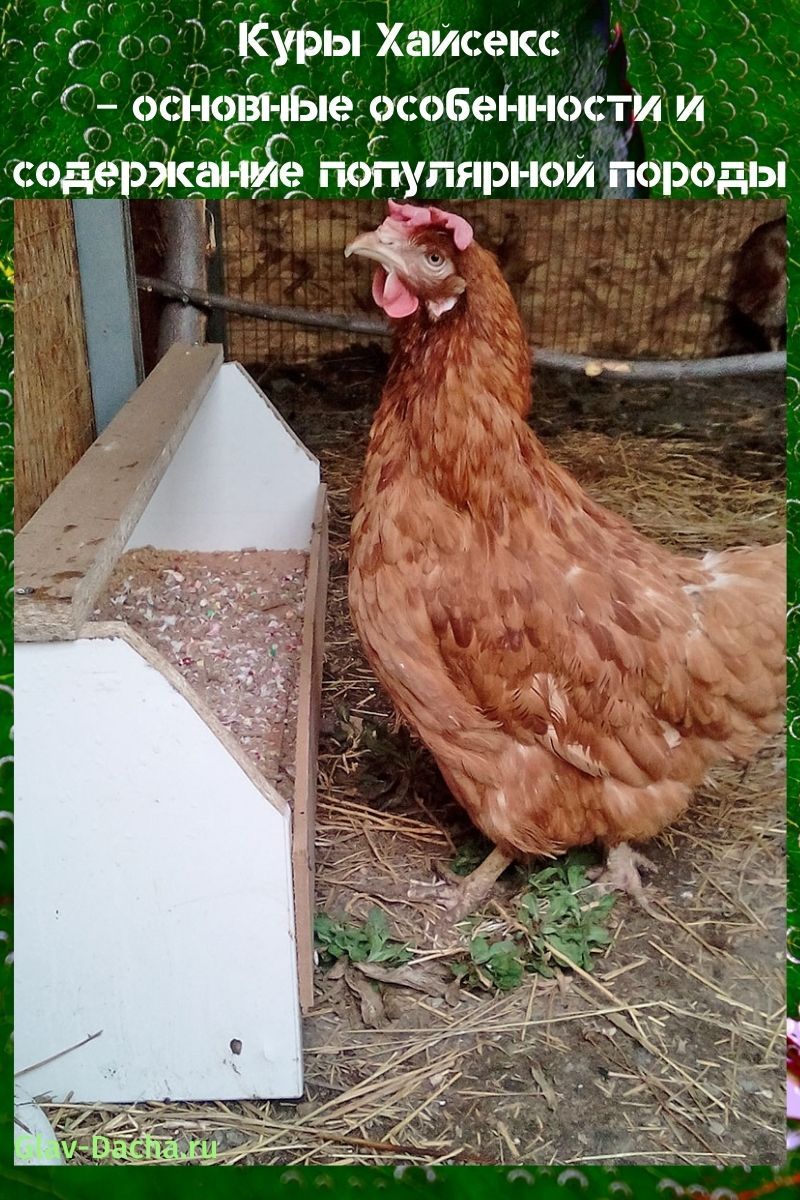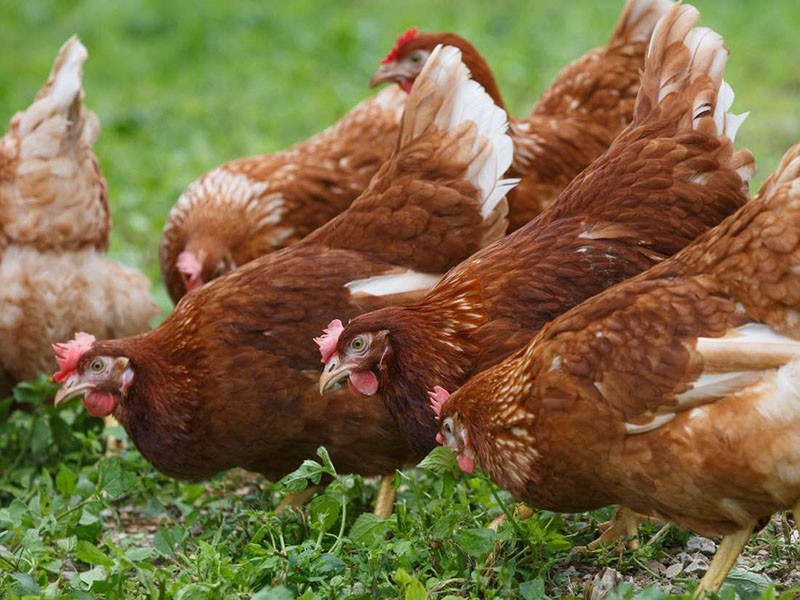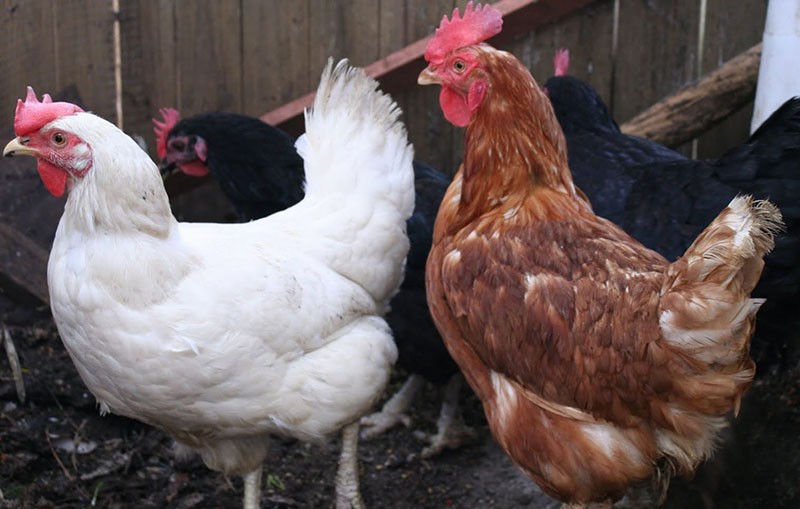Hisex chickens - the main features and content of the popular breed
 The main task of livestock breeders is to breed highly productive breeds with minimal requirements for breeding conditions and care. It is precisely these requirements that Hisex chickens meet - one of the most popular and sought-after crosses, bred in Holland. This bird is intended for breeding both on the largest industrial poultry farms and on small, private farms. With unpretentious maintenance and minimal feed consumption, the farmer gets an excellent yield of high-quality meat and egg products.
The main task of livestock breeders is to breed highly productive breeds with minimal requirements for breeding conditions and care. It is precisely these requirements that Hisex chickens meet - one of the most popular and sought-after crosses, bred in Holland. This bird is intended for breeding both on the largest industrial poultry farms and on small, private farms. With unpretentious maintenance and minimal feed consumption, the farmer gets an excellent yield of high-quality meat and egg products.
Chickens Hisex - features and description

Description of Hisex chickens:
- The main feature of the breed is the highest possible productivity - chickens lay eggs almost every day, maintaining this ability for 3-4 years.
- The eggs are large in size - up to 70-90 g.
- Laying hens usually weigh less than 2 kg, males can reach 3 kg.
- A distinctive feature of the breed is a large, fleshy and drooping red comb.
- The physique is harmonious, the body is of the correct shape.
- The age of puberty is 3, -4.5 months.

The Hisex chicken breed has two subspecies - Brown and White. They differ not only in plumage color, but also in weight, productivity and some other characteristics.
Hisex Brown
 Cross Hisex Brown is considered more popular with farmers and poultry farmers than White. He got this name for the brown color of the plumage. Cross is larger than White - up to 2.4-3 kg.
Cross Hisex Brown is considered more popular with farmers and poultry farmers than White. He got this name for the brown color of the plumage. Cross is larger than White - up to 2.4-3 kg.
Hisex Brown traits:
- excellent chick survival - up to 99%;
- rapid growth and weight gain in young animals;
- high egg production - up to 300-330 eggs per year;
- the average egg weight is slightly less than that of the White cross - up to 75 g;
- eggs are covered with a beige-brown shell;
- the meat is quite tough in both adult chickens and chickens.
Hisex has a calm and docile nature. Chickens and roosters get along well both with other birds and with poultry farmers. Many farmers call them tame, as brown Hisex quickly gets used to stroking.
Hisex White
 Cross Hisex White is distinguished by its snow-white plumage and smaller size in comparison with the brown "brothers". The average weight of an adult laying hen is no more than 1.7-1.9 kg, roosters can weigh up to 2.2-2.5 kg.
Cross Hisex White is distinguished by its snow-white plumage and smaller size in comparison with the brown "brothers". The average weight of an adult laying hen is no more than 1.7-1.9 kg, roosters can weigh up to 2.2-2.5 kg.
The survival rate of Hisex White chickens is slightly lower - up to 91-95%. At the same time, their egg production is lower than the Brown cross. Most often, it does not exceed 285-295 eggs per year, the weight of which is also much less - up to 50-65 g.
Cross Hisex White most often has a calm, phlegmatic character, but young cocks can be aggressive. In contrast to brown "brothers", white chickens are much more demanding in terms of keeping conditions, temperature and humidity of the air, as well as the quality of feed. That is why Hisex Brown birds are often used for keeping at home.
Keeping hens of the Hisex breed
 Hisex chickens, like all hybrids, will demonstrate maximum productivity only when optimal conditions are created. Keeping Hisex requires proper arrangement of the poultry house, free range, balanced feeding.
Hisex chickens, like all hybrids, will demonstrate maximum productivity only when optimal conditions are created. Keeping Hisex requires proper arrangement of the poultry house, free range, balanced feeding.
The advantage of Hisex birds is a strong immune system, due to which they are extremely rarely susceptible to various diseases.
Poultry house arrangement
 For Hisex chickens, warmth and protection from drafts are very important. It is best to keep birds in a brick, concrete or wood hen house. The floor must be insulated. To do this, you can pour a layer of sawdust, peat or straw up to 15-20 cm thick.
For Hisex chickens, warmth and protection from drafts are very important. It is best to keep birds in a brick, concrete or wood hen house. The floor must be insulated. To do this, you can pour a layer of sawdust, peat or straw up to 15-20 cm thick.
Basic requirements for a poultry house:
- Hisex layers are very demanding on lighting, a lack of light negatively affects their productivity. The house must have windows and artificial light sources.
- For adult chickens, daylight hours should be at least 17-18 hours. Hisex chicks need lighting for 22-23 hours.
- IN poultry house it is necessary to maintain the air temperature not lower than + 13 °, otherwise the birds will not only stop rushing, but may simply freeze.
- An increased level of air humidity is destructive for Hisex chickens, so you need to monitor its indicators.
- The perches should be installed along the walls, at a level of 55-60 cm from the floor surface.
- Special hay nests for laying hens should be installed in the corners of the house.
Representatives of the cross are active and energetic, so they need enough free space - about 1 meter for 4-5 birds.
In the poultry house, it is imperative to install a sufficient number of drinkers and feeders, as well as containers with shell rock, gravel and sand.
Walking chickens
 In the summertime, it is recommended that Hisek chickens be allowed to walk so that they can clean themselves and take dry baths. It is advisable to install a walking yard near the chicken coop, in a shaded and wind-protected place.
In the summertime, it is recommended that Hisek chickens be allowed to walk so that they can clean themselves and take dry baths. It is advisable to install a walking yard near the chicken coop, in a shaded and wind-protected place.
 It is imperative to make a canopy over the walking area, which will protect the birds from the scorching sun and rain. It should also be protected with a plastic or metal mesh protection at least 1 m high.
It is imperative to make a canopy over the walking area, which will protect the birds from the scorching sun and rain. It should also be protected with a plastic or metal mesh protection at least 1 m high.
Many farmers set up a walking yard around the house so the chickens can go for a walk on their own without assistance.
Feeding chickens
 When breeding Hisex chickens on poultry farms, complex feed is used in the calculation of 100-115 g per day. They saturate the body of birds with all the necessary microelements and nutrients, provide high productivity, but are distinguished by high cost.
When breeding Hisex chickens on poultry farms, complex feed is used in the calculation of 100-115 g per day. They saturate the body of birds with all the necessary microelements and nutrients, provide high productivity, but are distinguished by high cost.
That is why, when breeding at home, such compound feeds are used extremely rarely.
They are being replaced by more affordable feeds, which include:
- cereals - wheat, oats, barley;
- legumes;
- corn;
- fish and meat and bone meal;
- nettles and other fresh grass;
- vegetables;
- cake and meal;
- greens.
To increase productivity, adult layers must be given various supplements with calcium content - chalk or crushed eggshells.
Adult chickens are fed three times a day, chickens need to be fed 7-8 times a day.
Breeding and raising chickens
 At home, breeding the Highsek breed, like other hybrids, is impossible. Birds lack maternal instinct, so they never hatch eggs. For breeding chickens, eggs are purchased and grown in incubators or grown chickens in poultry farms.
At home, breeding the Highsek breed, like other hybrids, is impossible. Birds lack maternal instinct, so they never hatch eggs. For breeding chickens, eggs are purchased and grown in incubators or grown chickens in poultry farms.
The best time to buy chicks is in late May or June, when the weather is warm and there is sufficient daylight hours. For the first 5-7 days, chicks should be under 24-hour lighting, which is gradually reduced.
For feeding chickens, mixtures of chopped greens, dandelion, sorrel, boiled eggs are used. After 15 days, the chicks are transferred to "adult" food.
 Hisex chickens are one of the most common breeds, distinguished by excellent productivity, egg production and unpretentiousness to keeping conditions. The simplicity and ease of care have led to the popularity of the cross both among large farms and among small household farms.
Hisex chickens are one of the most common breeds, distinguished by excellent productivity, egg production and unpretentiousness to keeping conditions. The simplicity and ease of care have led to the popularity of the cross both among large farms and among small household farms.